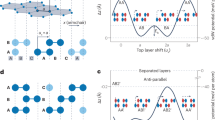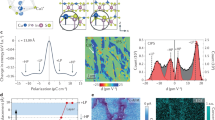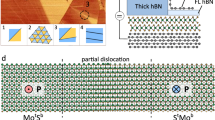Abstract
Expanding the performance of field-effect devices is a key challenge of the ever-growing chip industry at the core of current technologies1. Non-volatile multiferroic transistors that control atomic movements rather than purely electronic distribution are highly desired2. Recently, a field-effect control over structural transitions was achieved in commensurate stacking configurations of honeycomb van der Waals (vdW) polytypes by sliding boundary strips between oppositely polarized domains3,4,5,6. This ferroelectric hysteretic response, however, relied on pre-existing dislocation strips between relatively large micron-scale domains, severely limiting practical implementations3,7,8. Here we report the robust electric switching of single-domain polytypes in nanometre-scale islands embedded in super-lubricant vdW arrays. We etch cavities into a thin layered spacer and then encapsulate it with functional flakes. The flakes above/under the lattice-mismatched spacer sag and touch at each cavity to form islands of commensurate and metastable polytype configurations. By imaging the polarization of the polytypes, we observe nucleation and annihilation of boundary strips and geometry-adaptable ferroelectric hysteresis loops. Using mechanical stress, we further control the position of boundary strips, modify marginal twist angles and nucleate patterns of polar domain. This super-lubricant arrays of polytype (SLAP) concept suggests ‘slidetronics’ device applications such as elastic-coupled neuromorphic memory cells and non-volatile multiferroic tunnelling transistors and programmable response by designing the size, shape and symmetry of the islands and of the arrays9.
This is a preview of subscription content, access via your institution
Access options
Access Nature and 54 other Nature Portfolio journals
Get Nature+, our best-value online-access subscription
$32.99 / 30 days
cancel any time
Subscribe to this journal
Receive 51 print issues and online access
$199.00 per year
only $3.90 per issue
Buy this article
- Purchase on SpringerLink
- Instant access to full article PDF
Prices may be subject to local taxes which are calculated during checkout



Similar content being viewed by others
Data availability
All of the data in the experiments and analysis that support the findings of this study are included in the main paper and Methods. Any other relevant data are available at https://doi.org/10.5281/zenodo.14082606 (ref. 48).
References
International Roadmap for Devices and Systems. IEEE https://doi.org/10.60627/0p45-zj55 (2023).
Wuttig, M. & Yamada, N. Phase-change materials for rewriteable data storage. Nat. Mater. 6, 824–832 (2007).
Vizner Stern, M. et al. Interfacial ferroelectricity by van der Waals sliding. Science 372, 1462–1466 (2021).
Yasuda, K., Wang, X., Watanabe, K., Taniguchi, T. & Jarillo-Herrero, P. Stacking-engineered ferroelectricity in bilayer boron nitride. Science 372, 1458–1462 (2021).
Weston, A. et al. Interfacial ferroelectricity in marginally twisted 2D semiconductors. Nat. Nanotechnol. 17, 390–395 (2022).
Wang, X. et al. Interfacial ferroelectricity in rhombohedral-stacked bilayer transition metal dichalcogenides. Nat. Nanotechnol. 17, 367–371 (2022).
Ko, K. et al. Operando electron microscopy investigation of polar domain dynamics in twisted van der Waals homobilayers. Nat. Mater. 22, 992–998 (2023).
Gao, Y. et al. Tunnel junctions based on interfacial two dimensional ferroelectrics. Nat. Commun. 15, 4449 (2024).
Vizner Stern, M., Salleh Atri, S. & Ben Shalom, M. Sliding van der Waals polytypes. Nat. Rev. Phys. https://doi.org/10.1038/s42254-024-00781-6 (2024).
Yamada, N. et al. High speed overwritable phase change optical disk material. Jpn. J. Appl. Phys. 26, 61–66 (1987).
Cheong, S.-W. & Mostovoy, M. Multiferroics: a magnetic twist for ferroelectricity. Nat. Mater. 6, 13–20 (2007).
Li, L. & Wu, M. Binary compound bilayer and multilayer with vertical polarizations: two-dimensional ferroelectrics, multiferroics, and nanogenerators. ACS Nano 11, 6382–6388 (2017).
Fei, Z. et al. Ferroelectric switching of a two-dimensional metal. Nature 560, 336–339 (2018).
Woods, C. R. et al. Charge-polarized interfacial superlattices in marginally twisted hexagonal boron nitride. Nat. Commun. 12, 347 (2021).
Alden, J. S. et al. Strain solitons and topological defects in bilayer graphene. Proc. Natl Acad. Sci. USA 110, 11256–11260 (2013).
Lebedeva, I. V., Lebedev, A. V., Popov, A. M. & Knizhnik, A. A. Dislocations in stacking and commensurate-incommensurate phase transition in bilayer graphene and hexagonal boron nitride. Phys. Rev. B 93, 235414 (2016).
Kushima, A., Qian, X., Zhao, P., Zhang, S. & Li, J. Ripplocations in van der Waals layers. Nano Lett. 15, 1302–1308 (2015).
Popov, A. M., Lebedeva, I. V., Knizhnik, A. A., Lozovik, Y. E. & Potapkin, B. V. Commensurate-incommensurate phase transition in bilayer graphene. Phys. Rev. B 84, 045404 (2011).
Tang, P. & Bauer, G. E. W. Sliding phase transition in ferroelectric van der Waals bilayers. Phys. Rev. Lett. 130, 176801 (2023).
Yasuda, K. et al. Ultrafast high-endurance memory based on sliding ferroelectrics. Science 385, 53–56 (2024).
Bian, R. et al. Developing fatigue-resistant ferroelectrics using interlayer sliding switching. Science 385, 57–62 (2024).
Li, H. et al. Global control of stacking-order phase transition by doping and electric field in few-layer graphene. Nano Lett. 20, 3106–3112 (2020).
Deb, S. et al. Cumulative polarization in conductive interfacial ferroelectrics. Nature 612, 465–469 (2022).
Atri, S. S. et al. Spontaneous electric polarization in graphene polytypes. Adv. Phys. Res. 3, 2300095 (2024).
Cao, W. et al. Polarization saturation in multilayered interfacial ferroelectrics. Adv. Mater. 36, 2400750 (2024).
Zhou, H., Xie, T., Taniguchi, T., Watanabe, K. & Young, A. F. Superconductivity in rhombohedral trilayer graphene. Nature 598, 434–438 (2021).
Huang, B. et al. Electrical control of 2D magnetism in bilayer CrI3. Nat. Nanotechnol. 13, 544–548 (2018).
Shi, Y. et al. Electronic phase separation in multilayer rhombohedral graphite. Nature 584, 210–214 (2020).
Lu, Z. et al. Fractional quantum anomalous Hall effect in multilayer graphene. Nature 626, 759–764 (2024).
Hirano, M. & Shinjo, K. Atomistic locking and friction. Phys. Rev. B 41, 11837–11851 (1990).
Dienwiebel, M. et al. Superlubricity of graphite. Phys. Rev. Lett. 92, 126101 (2004).
Leven, I., Krepel, D., Shemesh, O. & Hod, O. Robust superlubricity in graphene/h-BN heterojunctions. J. Phys. Chem. Lett. 4, 115–120 (2013).
Constantinescu, G., Kuc, A. & Heine, T. Stacking in bulk and bilayer hexagonal boron nitride. Phys. Rev. Lett. 111, 036104 (2013).
Li, H. et al. Electrode-free anodic oxidation nanolithography of low-dimensional materials. Nano Lett. 18, 8011–8015 (2018).
Gruverman, A. et al. Mechanical stress effect on imprint behavior of integrated ferroelectric capacitors. Appl. Phys. Lett. 83, 728–730 (2003).
Lu, H. et al. Mechanical writing of ferroelectric polarization. Science 335, 59–61 (2012).
Tsuji, T., Irihama, H. & Yamanaka, K. Observation of anomalous dislocation behavior in graphite using ultrasonic atomic force microscopy. Jpn. J. Appl. Phys. 41, 832–835 (2002).
Jiang, L. et al. Manipulation of domain-wall solitons in bi- and trilayer graphene. Nat. Nanotechnol. 13, 204–208 (2018).
Ribeiro-Palau, R. et al. Twistable electronics with dynamically rotatable heterostructures. Science 361, 690–693 (2018).
Yang, Y. et al. In situ manipulation of van der Waals heterostructures for twistronics. Sci. Adv. 6, eabd3655 (2020).
Gilbert, S. M. et al. Alternative stacking sequences in hexagonal boron nitride. 2D Mater. 6, 021006 (2019).
Wu, H. et al. Direct visualization and manipulation of stacking orders in few-layer graphene by dynamic atomic force microscopy. J. Phys. Chem. Lett. 12, 7328–7334 (2021).
Inbar, A. et al. The quantum twisting microscope. Nature 614, 682–687 (2023).
Tang, H. et al. On-chip multi-degree-of-freedom control of two-dimensional materials. Nature 632, 1038–1044 (2024).
Nery, J. P., Calandra, M. & Mauri, F. Long-range rhombohedral-stacked graphene through shear. Nano Lett. 20, 5017–5023 (2020).
Bosse, J. L., Lee, S., Andersen, A. S., Sutherland, D. S. & Huey, B. D. High speed friction microscopy and nanoscale friction coefficient mapping. Meas. Sci. Technol. 25, 115401 (2014).
Zhang, X., Yu, K., Lang, H., Huang, Y. & Peng, Y. Friction reduction of suspended multilayer h-BN based on electrostrain. Appl. Surf. Sci. 611, 155312 (2023).
Yeo, Y. Polytype switching by super lubricant van der Waals cavity arrays. Zenodo https://doi.org/10.5281/zenodo.14082606 (2024).
Acknowledgements
We thank N. Ravid and I. Malker for laboratory support. K.W. and T.T. acknowledge support from the JSPS KAKENHI (grant numbers 21H05233 and 23H02052) and World Premier International Research Center Initiative (WPI), MEXT, Japan. M.B.S. acknowledges support from the European Research Council under the European Union’s Horizon 2024 research and innovation programme (‘SlideTronics’, consolidator grant agreement no. 101126257) and the Israel Science Foundation under grant nos 319/22 and 3623/21. We further acknowledge the Center for Nanoscience and Nanotechnology of Tel Aviv University.
Author information
Authors and Affiliations
Contributions
Y.Y. performed the experiments, supported by Y.S., N.Ro. and N.Ra. and supervised by M.B.S. K.W. and T.T. provided the h-BN crystals. All authors contributed to the writing of the manuscript.
Corresponding author
Ethics declarations
Competing interests
Ramot at Tel Aviv University Ltd has applied for a patent (US application no. 63/676,819) on some of the technology and materials discussed here, for which Y.Y., Y.S., N.Ra. and M.B.S. are listed as co-inventors.
Peer review
Peer review information
Nature thanks the anonymous reviewers for their contribution to the peer review of this work.
Additional information
Publisher’s note Springer Nature remains neutral with regard to jurisdictional claims in published maps and institutional affiliations.
Extended data figures and tables
Extended Data Fig. 2 Comparison of spacer lithography methods.
a,b, AFM and optical microscope image of local anodic oxidation lithography with cavity diameter down to about 20 nm. c,d, AFM and optical image of laser pulse lithography.
Extended Data Fig. 3 Imaging ferroelectric hysteresis loop for a 150-nm cavity.
Device 2; see Fig. 2. Domain pattern imaged by KPFM after bias scans at the voltage and time indicated on each map.
Extended Data Fig. 4 Further ferroelectric hysteresis measurements (device 2).
a, Topographic and KPFM maps of the cavity array. b–d, Hysteresis loops of the cavities marked in a, with diameters of 150, 250 and 350 nm, respectively. Bright and dark column stands for the switching to complete up-polarization and down-polarization.
Extended Data Fig. 5 Triangular intermediate transition states (device 2).
a, Topographic image of a 250-nm cavity. b–d, KPFM image measured before and after applying bias scans as indicated in each map.
Extended Data Fig. 6 Determination of threshold pressure for dislocation movement.
a, Topographic AFM image of the measured array. b, KPFM signals before tip pressing. c, Successive pressing experiments. Scanning illustration and applied force indicate the contact-mode scan parameters before the KPFM image. Scale bar indicates 1 μm.
Extended Data Fig. 7 Imaging sagging of active layers (device 2).
a,b, Topography and surface potential maps of as-fabricated cavity array. c,d, Topographic and KPFM maps after AFM contact-mode scans at a pressure of 300 nN. Scale bars, 1 μm.
Extended Data Fig. 8 Friction force measurement around the cavity.
a, Friction force calibration curve measured in atomically flat h-BN. b, Topographic image of cavity in device 3 measured at 300-nN loading force. c, Corresponding friction force mapping at 300-nN applied normal force.
Rights and permissions
Springer Nature or its licensor (e.g. a society or other partner) holds exclusive rights to this article under a publishing agreement with the author(s) or other rightsholder(s); author self-archiving of the accepted manuscript version of this article is solely governed by the terms of such publishing agreement and applicable law.
About this article
Cite this article
Yeo, Y., Sharaby, Y., Roy, N. et al. Polytype switching by super-lubricant van der Waals cavity arrays. Nature 638, 389–393 (2025). https://doi.org/10.1038/s41586-024-08380-2
Received:
Accepted:
Published:
Issue Date:
DOI: https://doi.org/10.1038/s41586-024-08380-2
This article is cited by
-
Observation and manipulation of two-dimensional topological polar texture confined in moiré interface
Nature Communications (2025)



